Copyright 2020 - 2021 irantour.tours all right reserved
Designed by Behsazanhost
Iran National Museum
Iran National Museum
National Museum of Iran No visitor can afford to miss the National (Archaeological) Museum of Iran (in Imam Khomeini Ave), the country's mother museum established in 1937. If you make for the Louvre on arrival in Paris, this Museum is your spiritual home in Tehran, where objects unearthed during recent excavations are to be found side by side with objects representing the great periods of history and pre-history. It can be seen in one visit, but we recommend you two visits: one to the pre-historic, Achaemenian, and Sassanian finds on the first floor, and another to the Islamic objects on the second floor.
The Iran Bästan Museum is the first building specifically designed and built in Iran as a museum. It was designed by the French architect André Godard and built by two Iranian masons, Abbās-Ali Me'mar and Ostäd Morad Tabrizi between 1933 and 1936. Its traditional facade was inspired by the famous arch of Taq-e Kasrā in Ctesiphon, one of the famous examples of the architecture of the Sasanian period. The building’s brickwork exhibits the Persian tradition of brick construction.
The permanent exhibition covers a surface area of some 4,800 square meters over two floors and a basement, and houses over 2,000 selected artifacts in chronological order, from the Lower Paleolithic period, (ca. 1,000,000 years ago to the end of the Sasanid period (651 CE). The first floor galleries contain prehistoric objects including Paleolithic, Epipaleolithic, Neolithic, and Chalcolithic artifacts. The ground floor galleries contain historic objects including Bronze Age, Iron Age, Elamite, Achaemenid, Seleucid, Parthian, and Sasanian artifacts.
In a full day's visit, the tourist gets a comprehensive idea of Iranian art and culture through the ages. Prehistory and history merge in Iran: the dazzling sense of scale at Persepolis is anticipated in these very early works of decorated pottery. But most visitors come to admire a few much-photographed items which have become famous all over the world: Sialk pottery with astonishingly "modern" stylized decorations (11th-16th century BC); terra-cotta animals of the same period from the Caspian and Azarbaijan regions; several famous Lurestan bronzes (8th century BC); the famous delicately chiseled Marlik gold tankard with its decor of winged rams (10th century BC); and a copy of the Louvre's Code of Hammurabi to remind us that the original was excavated at Susa.
Visitors who do not have time to go to Persepolis or Susa will find in the National Museum of Iran significant vestiges of Achaemenian decorations: enameled brick panels, bull-head-shaped column capitals, gold plates engraved with royal decorations in three languages (ancient Persian, Babylonian, Elamite) and so on. Mosaics, coins, jewels, and household objects date back to the period of the Achaemenian and Sassanian kings.
The most striking section of the Museum, however, is the one showing the upheaval imposed by Islam on Iranian life and arts. It is another world that is reflected in Kufic's writing on wood, stone, precious fabrics, pottery, and parchment. Glasswork, ceramics with infinitely varied compositions, tapestries, and jewels show to what extent this civilization treasures everything which can bring beauty to everyday life. Visiting hours: 9:00-12:00 and 13:0016:00
Iran Bastan Museum from prehistory up to the Sasanids era
-Prehistoric Galleries
The Paleolithic Period Mobile Hunter-Gatherers (ca. 3.3 million to ca. 12 thousand years ago) In the long span of the Paleolithic period, humans lived in small bands with a nomadic lifestyle, making a living mainly from hunting wild animals and gathering wild plants. This period is characterized by the use of chipped stone tools and later antler and bone tools and the appearance of the Paleolithic period is sub-divided into Lower Paleolithic (ca. 3.300.000-250.000 years ago), Middle Paleolithic (ca. 250.000 - 40.000 years ago), and Upper Paleolithic (ca. 40.000 - 20.000 years ago), followed by Epipaleolithic(ca. 20.000 - 12.000 years ago).
 |
The most ancient artifacts in the museum (Gallery 1) are stone tools dating to the Lower Paleolithic period. These tools belong to times when early humans lived by means of hunting, scavenging, gathering, and foraging, and used stone tools for cutting animal flesh, making wooden tools, and other implements and objects. Remains of this period - mostly stone tools - have been discovered at archaeological sites such as Kashafrud in Khorasan, Lädiz in Sistan, and Baluchistan, Shiwatoo in Kurdistan, Ganj Par in Gilan, all open-air sites, and Darband Cave, also in Gilan.
In the Middle Paleolithic period bands of humans subsisted through actively hunting and gathering plant foods. During this period Neanderthals and early anatomically modem humans were roaming western Asia. Representative stone tools of this period made from flint and other rock types, and animal bones, some with cut marks, are on display in the Museum. These remains come from caves or open-air sites in the Zagros Mountains and the Iranian Plateau. Important stone tools of this period include points and side scrapers used for butchering hunted games and processing animal hides as well as other tasks. Examples of stone tools of this period from caves and rock shelters and open-air sites in the Zagros region (Bisotun, Lurestån, Arsanjan, Qaleh Bozi) and central Iran (Mirak, Niasar, Parvadeh, Zaviyeh) are on display in the museum (Gallery 2). One of the oldest human fossil remains from Iran, discovered in a small cave called Wezmeh near Kermanshah in the west-central Zagros, is on display. This is a human premolar tooth representing a late juvenile individual, who may have been the prey of carnivores such as hyenas and wolves whose remains are abundant in the Wezmeh Cave. A human radius (forearm) fragment from a Neanderthal has been discovered in Bisotun cave is located in the same region of the west-central Zagros.
The Upper Paleolithic period, which began around 40,000 years ago and came to a close about 20,000 years ago, coincides with the arrival of anatomically modem humans (also known as Homo sapiens sapiens) in Iran. In this period, the making of stone tools such as blades and bladelets expanded. personal ornaments like pendants made from shells, animal teeth, and a reddish-black iron mineral (hematite) appeared in this period, of which some examples from Yäfteh Cave are on display. Red ochre was also used quite abundantly. Among important sites dating to this period are Yafteh and Kaldar caves in Lurestan, Warwasi, Malāverd and Ghar-e Khar Cave in Kermanshāh, Sefid-Ab in Käshān, and Eshkaft-e Gavi and BoofCaves in Fars. Artifacts from some of these sites are on display in the Museum.
The next period - called the Epipaleolithic meaning terminal Paleolithic) - is characterized by composite tools, tools for processing plant material, and installations for storing foodstuff. The Epipaleolithic period begins around 20,000 years ago and goes on until the end of the Ice Age, about 12,000 years ago. Examples of tools and ornaments of this period from Ali Tappeh and Komishan caves in Mazandaran, Pa Sangar Rockshelter in Lurestàn, and a number of other sites are on display in the Museum hall (Gallery 3).
-The Neolithic and Chalcolithic Periods
The Age of Permanent Villages and Early Towns (ca. 10,000 to ca. 5,000 years ago) From the Late Epipaleolithic period mobile bands of hunter-gatherers gradually settled down in very small villages comprised of a handful of related families. The earliest such villages were established in the piedmont regions of the Zagros
 |
Mountains, where wild species of wheat, barley, sheep, goat, and pig were native. As these early villages managed to domesticate such species and attained control over their food supplies, populations grew and new villages were established in areas outside of the nuclear zones in the alluvial plains and lower broad valleys, such as Khuzestan, Färs, and Central Plateau. While the use of stone tools and stone vessels was known prior to the establishment of the early villages, the most important invention of the early Neolithic period was the use of baked or fired pottery vessels. This important craft, which seems to have been developed first in western and southwestern Iran, underwent a rapid change from crude, undecorated simple containers, to well-baked and sophisticated vessels of many different shapes and decorated with exquisitely painted designs.
Similarly, the simple adobe houses of the early villages, made of packed mud (known as pise) and thatched roofs, rapidly developed into multi-chambered houses made of mud bricks, and some were even decorated with multicolored paintings. The complexity of social relations and the crystallization of religious ideas led some larger villages to the erection of large and monumental buildings (temples) as the sites of communal worship. A huge collection of variously shaped decorated and plain clay figurines from almost every ancient village is another manifestation of such religious beliefs, the nature, and structure of which are not known to us. Examples of these figurines discovered at Sarab, and Sang-e Chakhmaq, are on display in the Museum. Stone tools hafted with bone or wooden handles were used in this period to harvest cereals, of which one from Sang-e Chakhmaq is on display.
This early Neolithic development was truly revolutionary in the long history of the human species. The "Neolithic Revolution" freed humans from the constant search for food and shelter. Control over food and a sedentary life quickly resulted in unprecedented growth in population. As the population grew and social interaction and conflict arose, the fabric of the society became more complex and new social norms and regulations developed to solve social problems. This inevitably led to the
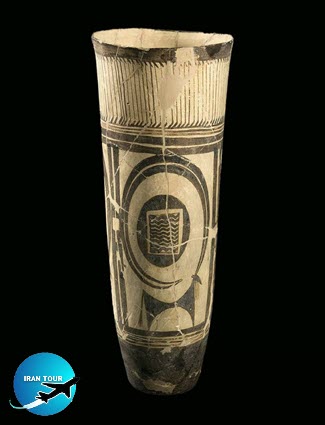 |
| Susa earthenware cup 6000 years ago |
the emergence of an elite dass to lead the community, economic differentiation, too, developed. This entire web of social development eventually led to another fundamental social change: the urban revolution" and the emergence of state societies. Just prior to the age of the urban revolution" around 4000 BCE, control of the economy by both individuals and social organizations, such as the temple or the community's chief house, was expressed by stamp seals that were developed around 5000 BCE. This early device for ownership and control of the flow of goods became another layer of social and economic complexity that finally around 3500 BCE resulted in the emergence of political organizations and states. Examples of such early seals, from sites like Bakun, Giyan, and Seh Gabi are on display.
The Formation of Early States and Urban Societies (ca. 3300 to ca. 559 BCE) The people belonging to Paleolithic bands and the Neolithic Chalcolithic societies were predominantly equal but, as the Chalcolithic period drew to a close, some societies became ranked and eventually stratified, meaning that some people belonged to lower status ranks with lesser access to goods, while some belonged to higher ranks with more access to resources. This development and the division of people into different classes paved the way for a major landmark in human history: the rise of states and the formation of civilizations.
there are assemblages from regions such as Jiroftand Shahdad, as well as Lurestan Bronzes, that occupy a prominent place in this period, but the ethnic identity of their makers still remains an enigma. During the Middle Bronze Age, the Iranian Plateau experienced a short fluorescence of urbanism. Urban centers on the plateau, including Shahr-i Sokhteh, Hissar, Yahya, Shahdad, and Jiroft, were linked through an exchange network that connected the plateau with Central Asia the southern
coast of the Persian Gulf, and the Sea of Oman, Elam, and Mesopotamia. Highly desirable commodities in this network included copper from central and southeastern Iran and Oman, lapis lazuli from Badakhshan in Afghanistan and Quetta in Pakistan, and stone from southwestern Iran and Oman. These materials reached their final destinations either in the form of raw materials or as finished goods. Lapis lazuli workshops have been discovered at Shahr-i Sokhteh and Hissar, while Yahya and Jiroft seem to have been centers for carving various objects from steatite and chlorite. A number of these carved products are on display on the ground floor of the Museum. A major technological
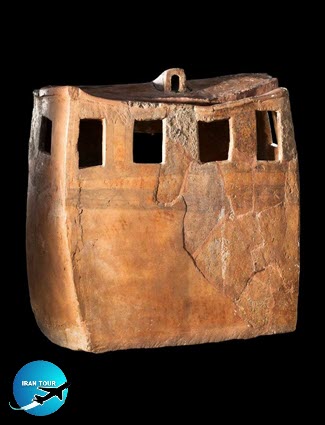 |
| Flint earthenware replica |
breakthrough in the Bronze Age was the introduction of bronze alloy by mixing copper and tin. This provided a suitable medium for a whole new range of artifacts, especially arms of different kinds (for clubbing and stabbing and types of projectiles), harnesses for beasts of burden, vessels of various types, and a whole array of personal ornaments. Examples on display in the Museum hall speak of a high level of craftsmanship.
As the indigenous cultures of Iran experienced a period of decline in the mid-second millennium BCE, waves of newly arrived Iranian-speaking peoples migrating to Iran from Central Asia began to inject a new spirit into Iranian life. The majority of these people took the southern route (south of the Alburz range) onto the central plateau and from there to the south to later become the Persians) or to the west (to later become the Medes) while some took the northern route (north of the Alburz range) into the Caspian basin where their splendid remains have been discovered in numerous graveyards such as Marlik. The new culture with its distinctive grey pottery that appeared on the northeastern plateau and replaced existing pottery at sites in the Gorgan Plain is commonly believed to represent the gradual migration of these Iranian-speaking peoples onto the Iranian Plateau. While in southwestern Iran the Elamites were engaged in warfare with the Assyrians, in northern regions i.e., the Central and Northern Zagros mountains and the center of the plateau) a number of newly established polities stepped out into history, consolidated their roots, watched the conflict between the Elamites and the Mesopotamians, gained experience, and in due course unleashed their force upon the Assyrians (the most powerful state in Mesopotamia at that time).
-The Achaemenids (559 to 330 BCE)
Of the Iranian-speaking peoples who migrated into Iran, one, in particular, the Persians-chose to head south, where they apparently settled in Fars (ancient Anshan),
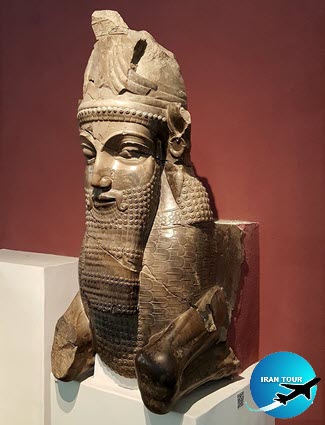 |
mingled with the native Elamite population, and formed a polity comprising Persian and Elamite elements that eventually led to the rise of the largest empire the world had seen up to that point. Following the wars of conquest by Cyrus the Great and his son and successor Cambyses, Darius the Great embarked on consolidating and structuring the Empire. It was he who introduced standardized coinage, called darics, that along with an extensive network of roads facilitated contact and interaction between people from distant comers of the Empire, both culturally and commercially. Egyptian objects discovered at Susa and Persepolis are fine examples of this large-scale cultural contact and interaction among the subjects of the Achaemenid Empire. Arts also flourished in the Achaemenid period: metalworking, stone-masonry, stone-carving, and glazed brick-working reached new heights, as shown by several fine examples on display in the Museum hall. Another innovation that can be seen in the Museum on several stone inscriptions in the Old Persian script introduced during the time of Darius the Great. Despite its power and glory and policy of tolerance, the Achaemenid Empire failed to withstand the better-equipped, battle-hardened, and tactically more competent Macedonian and Greek army led by Alexander the Great and fell in 330 BCE.
-The Seleucids (313 to 146 BCE)
One of Alexander's generals who succeeded him, Seleuais Nicator, chose Iran as his domain and established the Seleucid Empire. Seleucus had married a Persian princess and therefore attained his legitimacy before Iranians through his wife, but the discovery of a few sanctuaries for Greek gods and goddesses and the many Greek inscriptions and statuettes in Iran (some of which are on display in the Museum) is a testimony to the spread of Greek culture in Iran. This phenomenon influenced both the Seleucids and their eventual successors, the Arsacids, who rose up in defiance of the Seleucids in northeast Iran, and after a century of fighting drove them from Iranian soil.
|
The similarities between Persepolis of Achaemenid and Isfahan of the Safavid era |
-The Parthians (250 BCE to 224 CE)
Just as the Achaemenids-named after Achaemenes—were the ruling clan of the Persians, the Arsacids were named after Arsaces, the legendary founder of the dynasty
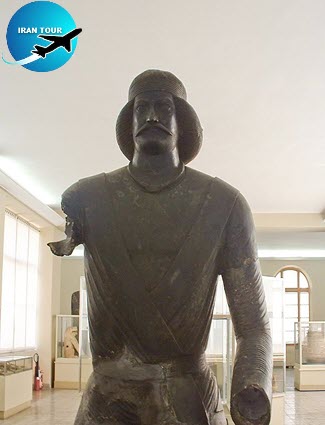 |
was the ruling dan of the Parthians, another Iranian tribe inhabiting the northeastern parts of Iran. As the Seleucid grip on this distant part of their empire began to loosen, the Arsacids and Parthians sought to grasp the opportunity to pursue their independence. The Parthians were master riders and marksmen who are still remembered today in expressions such as "the Parthian Shot. They were divided, however, into several clans that made their empire far less homogenous and centralized than those of their predecessors (Achaemenids) or successors (Sasanids). This system made the Parthians vulnerable to their new western neighbor, the mighty Roman Empire, which was gradually encroaching upon Western Asia, traditionally considered to be an Iranian territory. Despite several advances into the Parthian Empire and the capture and looting of Ctesiphon—the Parthian capital, not far from modern Baghdad-three times, Parthians managed to stand firm before the Roman juggernaut and even defeat and repulse them on a number of occasions. The damage, however, was done and the Arsacids lost their divine mandate before Iranians due to their successive defeats and they were soon overthrown and replaced by the Sasan ids. The Parthian period lacks a coherent corpus of arts and its art seems rather provincial compared to that of the Achaemenids or the Sasanids. Yet a number of splendid, but isolated finds underline the aesthetic and technological accomplishments of Parthian art. Perhaps first and foremost among these is the life-size bronze statue of a presumably Parthian nobleman discovered in the early 20 century in Shami in southwestern Iran and now on display in the Museum hall. The Parthians were also master glass-makers, and examples of this art can be found in the museum hall.
-The Sasanids (224 to 651 CE)
The Sasanids were from Persia - the homeland of the Achaemenids -and therefore had claimed the Achaemenid Persian legacy. Once the Arsacids had lost their divine mandate due to multiple defeats at the hands of the Romans, the Sasanids, under the ambitions of Ardashir I, a local dynast from the city of Istakhr, not far from Persepolis, rose in rebellion and defeated Artabanus V, the last Arsacid king-of-kings. They established a new dynasty, called the Sasanids, named after Sasan, the grandfather of Ardeshir I, evidently the chief priest of the temple of the goddess Anahità in Istakhr.
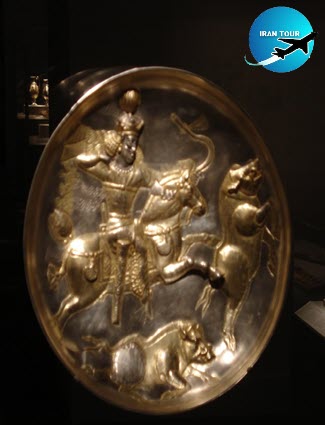 |
Unlike the Arsacids, the Sasanids strived to create a centralized and homogenous empire that allowed them to embark on a far more aggressive approach towards the Romans, pushing them back across the Euphrates, sometimes even farther west. The new Sasanid approach also translated into major construction works within Iran, including several cities that have been excavated (ie, Veh Ardešir and Bišapur) and many others (e.g.Jundišapur, Ivan-e Karkheh, Darabgerd, etc.) that await the archaeologist's trowel Similarly, in the arts, the Sasanian period witnessed a major renaissance, from many rock-reliefs and decorative stuccoes to personal ornaments, silver or gilded vessels, textiles, stamp seals with exquisite designs, and last but not least, beautifully executed and realistic images on coins. Several examples of different categories of Sasanian artifacts are on display in the Museum hall The Sasanids succeeded in creating another golden age in Iran but, towards the end of the dynasty, incessant war with the Romans, as well as internal feuds over the imperial throne, and economic problems due to salinization of agricultural land in Khuzestan and Mesopotamia (the bread-baskets of the Empire) exhausted the Sasanid Empire and made it easy prey for mounted tribesmen emerging from Arabia and bringing with them the message of Islam. The murder of Yazdgird III and the escape of what was left of the Sasanid royal family to China in the mid-seventh century CE marks the fall of the Sasan id dynasty and the end of ancient Iran, only to be followed by yet another glorious period under Islam.
- Details
- Category: Museums of Tehran






